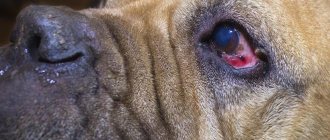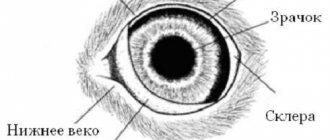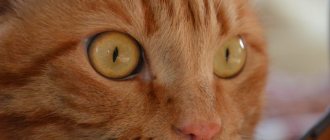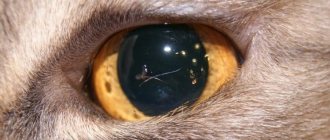What to do if a Pekingese's eye falls out: treatment and prevention
The Pekingese's Achilles heel is its eyes.
It is a rare representative of this breed that does not have regular problems with the organs of vision. And all because of the cute flattened face that captivates us at first sight. Dogs of this breed have a special, brachycephalic skull structure. Which means: their head is shortened and moderately flat. The Pekingese's eye sockets are shallow, and the eyeballs are quite large. The eyes seem to be constantly bulging, which leads to numerous vision problems.
In this article we will take a closer look at why Pekingese eyes fall out and how to help the animal in such a situation.
Causes of pathology
The scientific name for eye loss disease is proptosis. It happens quite often in Pekingese. The consequences of this pathology are always very dangerous and negative for a pet.
Important! The main reason for the development of proptosis is the structure of the animal’s skull. The eye sockets are not too large, the nose is flattened and raised too high, because of this the organs of vision are very vulnerable.
The causes of partial or complete loss of the eyeball can be:
- careless handling of the pet;
- injuries and bruises of the head, neck;
- unsuccessful, sudden jumps;
- too active games with children.
This is why your pet needs to be taken care of; it is advisable not to bring it into a family where there is a small child. In addition, you need to protect your pet from fights in the dog park and careless movements during walks.
First aid
Pekingese eyes fall out quite often. If you notice that one or both eyes of your dog are unnaturally bulging and red, the main thing is not to panic.
If no more than 10-15 minutes have passed since the injury, you can put the eye back in place yourself. But to do this, you must remain calm and strictly follow the instructions given below.
- Wash your hands thoroughly with soap and treat them with disinfectant. Remember that infection can lead to serious complications.
- Have a family member hold your Pekingese while you adjust his eye. The dog's head must be securely fixed.
- With one hand, spread the animal's eyelids as wide as possible, and with the other, apply a clean cloth soaked in saline to the eye and press on the protruding area of the eye. You should feel the eyeball sink in and snap back into place.
- Apply the swab moistened with saline solution to the eye again.
Even if the procedure was successful, you need to urgently take your Pekingese to the vet. He will conduct an examination to eliminate the risk of infection and prescribe further treatment.
Symptoms
Identifying eyeball prolapse is quite simple. In most cases this is visually noticeable. If partial loss occurs, this may be indicated by a dry cornea or increased tearing. The dog’s depressed state and increased anxiety also indicate pathology. Often there is bleeding and tissue swelling occurs, which can always be noticed.
Important! If you detect at least one of these signs, you must contact your veterinarian very quickly. Otherwise, the consequences for the animal will be negative.
Complications
In most cases, negative consequences can be avoided if the necessary measures are taken when the first signs of ptosis appear.
These complications are possible if the eye remains dislocated for a long time or if an infection occurs during reduction:
- strabismus;
- corneal ulcer;
- gradual or sudden deterioration of vision;
- disruption of the optic nerve;
- blindness.
How to help a Pekingese if his eyes are falling out?
Animals sense a change in their owner’s mood, so you need to overcome fear and fear of the unknown, and also act as quickly as possible. The dog must be carefully taken to a veterinary clinic, where it will receive proper care.
Important! Experts do not recommend attempting to “set” the eyeball yourself; this can lead to complete blindness or death of the animal.
The action algorithm for the owner of a sick dog should be as follows:
- put a plastic “collar” on the animal’s neck, which will protect the damaged eye from the touches of the pet itself; if this is not the case, you will have to carefully monitor the dog;
- soak a clean napkin (non-woven, lint-free) with clean water and wipe the damaged eye from blood and dirt;
- lubricate it with eye ointment;
- call a veterinarian at home or send it to the clinic yourself.
Pathology can lead to negative consequences, and in severe cases, to the death of the pet. Therefore, everything needs to be done promptly to save the Pekingese’s eyesight.
Precautionary measures
As we have already said, you need to walk in specially designated places where there are no large canines, and also no plantings whose branches can injure the dog’s eyes. Every walk should be a joy for your dog, because stress can also weaken the muscles that support the eyes.
As you understand, this is a common problem and veterinarians are already accustomed to such a phenomenon as eye realignment in dogs with a short muzzle - Pekingese, pugs.
Source: https://aquatech-spb.ru/zdorove/u-pekinesa-vypali-glaza.html
First aid
An attentive dog owner will be able to notice such a situation in time. If a short amount of time has passed (no more than 10 minutes), then the Pekingese owner can try to return the eye with his own hands. After more time, it is necessary to use a napkin with saline solution, moisturizing the cornea.
With independent
realignment of the eye:
- the dog must be immobilized, preferably with the help of other people;
- place it on a non-slip surface;
- it is necessary to treat clean hands with an antiseptic;
- It is advisable to have a solution of novocaine in the first aid kit - before starting the reduction, you can anesthetize and rinse the eye;
- To relieve swelling, you can use cold - it is possible to use ice cubes in a piece of cloth. Direct contact with the eye is not allowed. We must not forget to pre-treat the ice with an antiseptic. Mandatory ice change every 5 minutes. In general, it is forbidden to use cold for more than 10 minutes;
- holding the lower jaw with one hand, carefully insert the eye into the socket with the other hand using a moistened napkin;
- As the napkin dries, it must be moistened and changed;
- You should definitely consult a doctor about correct eye alignment.
If time is lost, you should not try to straighten the dislocation yourself. You need to urgently contact a veterinary clinic. The veterinarian will prescribe treatment, possibly surgical in the form of suturing the eyelids. This type of treatment is temporary, then the suture is removed. Typically, the course of therapy takes about a month.
In case of irreversible changes in the eye or orbit, the organ of vision is removed. In the postoperative period, the use of a collar is mandatory. This method protects the eyes from damage by the dog itself. The healing tissue may itch, the dog will be worried and without a collar, the stitches will be damaged. The Pekingese owner must ensure that this recommendation is followed.
What to do if a Pekingese's eye falls out?
Today we will look at such an important topic as eye loss in the Pekingese breed. What to do if a Pekingese's eye falls out? First of all, take the problem seriously, but without fanaticism. So if you try to put the eye back without certain skills, you can make it even worse. After such manipulations, it is likely that your pet will undergo surgery.
It is better to immobilize the eye and gently but quickly refer the dog to a veterinarian. Let's figure out together why and in what cases eye loss is possible and how to prevent this phenomenon. How to treat, how to correct and how to care for the Pekingese in the future.
Unique breed
The Pekingese can well be called a royal breed, a breed of emperors and court ladies. This unique short-faced dog has an attractive appearance, fluffy “hairstyle” and at the same time an original wayward character.
This is not a Chihuahua, but a lion dog, or as it is also called a monkey dog.
There is a legend that once upon a time feelings flared up between a lion and a monkey and such a unique baby was born with the character and mane of a lion, but with the face of a monkey.
The legend, of course, is beautiful, but there is some truth in it - a truly noble appearance and character are combined in an original way with a comical monkey face. But the anatomical structure of the Pekingese's flattened muzzle is their advantage and at the same time their misfortune.
Imperial dogs have to withstand constant stress on the respiratory system. They often snore during sleep. By the way, they grunt like this while walking because of difficulty breathing. And eyes are a special topic that we want to talk about in detail.
Pekingese Eye Care
If a Pekingese has settled in your house, his eyes often fall out - you should know about this and protect the dog from this in advance. The Pekingese's eyes are special - they are too bulging and this goggle-eyed look means that you must treat them with care!
When keeping Pekingese, eye care is paramount. For a Pekingese on a walk, every speck of dust matters. That is, it doesn’t matter where you walk, but a speck or speck of dust gets into your eyes and needs to be removed when you get home.
You might say, is it really necessary to wash your eyes every time? Yes, this is a mandatory procedure for all Pekingese, because you want your pet’s eyes not to become inflamed? So, after a walk outside, wash them with chamomile decoction, tea leaves or a special lotion that you can buy at the pharmacy.
Why do specks quickly get into the eyes? It’s just that the Pekingese has too small recesses for the eyes and the eyeballs, one might say, are held on mainly by the eyelids. And the eyelids cannot cover the eyes well enough. This raises a number of problems:
- Ingress of dust and debris;
- You cannot walk in tall grass, under low branching trees and bushes;
- Approaching larger dogs is dangerous for the Pekingese;
- With severe inflammation or careless handling of the dog, the eye can literally pop out of its socket.
The loss of an eye is fraught with dangerous consequences, so if you do not correct the eye in time, you can lose an important part of your pet’s organ. This phenomenon can also occur when the muscle tension of the eye weakens - when the dog becomes seriously ill.
How to restore the eye to its place?
Prepare a place where the dog will not slip on the surface. Also prepare a napkin - ideally a clean cotton shawl! It is better if you have an assistant, but you can do it yourself. Wash your hands to avoid infection and get to work!
First assess your capabilities - whether you can act quickly, gently, but accurately. Take a look at your eyelids - if they are completely closed behind the eyeball, it will be difficult to cope, then it is better to see a doctor. If the injury occurred 5-10 minutes ago, and the eye is about half out, it is quite possible to cure the pet.
So, if you have already washed your hands, take a cotton swab or pad, or a clean handkerchief. Wet it with cold, but not ice-cold, water.
- Sit your pet down; he's probably acting restless and doesn't want to obey. Grab him firmly by the cheekbones with your left hand.
- Place your index finger and thumb on your eyelids and stretch them in different directions, while with the other hand, place the cotton pad on your eye and carefully, quickly but gently insert it back. You will feel the eye slide back if everything worked out.
- Regardless of the result, apply a warm swab soaked in saline solution - sodium chloride and see a doctor as soon as possible.
If more time has passed, the conjunctiva may dry out. To prevent this from happening, also moisten the eye with saline solution - not necessarily warm - and contact the clinic. Putting off going to the doctor is dangerous, and being afraid of surgery is also dangerous. This will not affect the dog's health.
Dogs live with one eye and look at the world with one eye. We do not want to say that surgery is a given in such cases and we do not wish the worst for your dog! The doctor himself knows what to do and will see it during the examination. Most likely, after the dog's eye is set, stitches will be placed to close the eyelids together.
This is also not something to be afraid of. When the stitches are removed, the eye will already be in place. Also, to restore the body and get rid of a possible infection, the veterinarian prescribes certain medications, and even antibiotics. Take your pet's health seriously, and a speedy recovery will not be long in coming.
Source: https://kidsdogs.ru/zdorove/u-pekinesa-vypal-glaz.html
Precautionary measures
As we have already said, you need to walk in specially designated places where there are no large canines, and also no plantings whose branches can injure the dog’s eyes. Every walk should be a joy for your dog, because stress can also weaken the muscles that support the eyes.
As you understand, this is a common problem and veterinarians are already accustomed to such a phenomenon as eye realignment in dogs with a short muzzle - Pekingese, pugs.
But you should also know how to straighten your eye if there is no veterinarian on site or if you are in a rural area and there is no way to get to a veterinarian. But first, you should try to prevent such incidents from happening to your furry friend of noble blood.
Don't let children point at the Pekingese's eye, it's dangerous. Therefore, families with small children should not have a Pekingese. Also make sure that the Pekingese does not jump from heights, this can damage the ligaments.
Keep your entire body clean, and examine your eyes especially often. After sleep, every walk, after active play in nature and meeting a big dog. If your eyes are red, be sure to rinse them; the blood vessels under the eyelid should be pink, not bright red. This indicates inflammatory processes. Purulent discharge indicates a bacterial infection, which can also lead to a weakening of the immune system and the muscles themselves.
If it falls out accidentally as a result of an injury, every minute is precious; if you do not insert it back, this is fraught with blindness, swelling of the eye socket and complete tissue death.
But veterinary medicine does not stand still, and for such problems doctors recommend eyelid enlargement (plasty). This is a special operation where incisions are made in the dog so that the dog's eyelids close more. This operation helps prevent many problems. At least reduce their frequency.
The Pekingese's eyes are falling out: what to do, the cause of the disease
If your Pekingese's eye falls out, don't panic, this is a common occurrence for the breed. To help a friend correctly and to resolve the situation correctly, you need to know what to do in such a difficult situation and how to subsequently avoid it.
Loss of an eyeball in a dog is no joke and requires immediate intervention, but it is not fatal.
This cute, royal dog has earned enormous popularity, but unfortunately, its interesting appearance, first of all, has many health consequences.
Frequent breathing problems due to anatomically narrow nasal passages, and the Pekingese often suffers when eyes fall out - which are the main problems of the breed.
The Pekingese is not the only dog with eye problems, among such breeds: the pug, the Japanese chin.
Help your pet
Don't panic, the less time you need to solve the problem, the better.
Assess the situation - if the missing eye has not completely fallen out, and no more than 15 minutes have passed, then you can help your friend on your own.
If a lot of time has passed, and the eye has slipped out quite strongly and you are in doubt, then apply a napkin soaked in saline solution to the eye, fix it and go to the veterinarian urgently or call a doctor at home.
Find a convenient place in the house where you can restrain your dog. It is very important that the dog is on a non-slip surface; it will be better if someone at home can help you.
Wash your hands thoroughly, or better yet, use an antiseptic. Wipe dry.
Secure the dog with your hand, by the lower jaw - take a clean, cotton scarf or cloth, make sure that there is no foreign material on it - threads or lint.
Moisten with warm water; ideally, a solution of furatsilin or saline solution is also suitable.
Spread your eyelids up and down with two fingers, use a napkin to press on the eye, do everything carefully, but clearly according to the recommendations; when the eye goes inside, you will feel how it has sunk.
Apply a cloth moistened with an antiseptic or sodium chloride solution (saline) - take it to the clinic for examination by a doctor or call him at home.
Often, when there is a big loss of time, when it is no longer possible to do without a specialist, doctors put stitches on the dog’s eyelids so that they come together faster - do not be afraid of this procedure, it will help the pet.
Prevention and care
- Examine your dog's eyes daily, rinse with a special solution or chamomile decoction.
- See if there is any discharge from the eyes.
- The mucous membranes should always be pink and the conjunctiva white.
- Do not allow large dogs to play with, only small and non-aggressive friends.
- Leave with caution with children.
- Visit your veterinarian for a routine checkup.
- Surgical prevention of loss is a full-fledged operation, but if such cases are frequent with your pet, correction solves the problem.
- When walking on the street, pay attention to what your pet is doing, do not let him climb through trash cans and stir in the dust.
- Avoid fighting with other animals. Don't walk in tall grass, avoid bushes.
- Don't shake the dog.
Causes of eyeball dislocation
- Anatomical features of the structure of the Pekingese eye socket.
- Big main apple, small eye sockets.
- Inflammatory, infectious diseases.
- Careless handling of a dog.
- Jumping from high places.
Why do Pekingese eyes fall out and how to help your pet?
The Pekingese's Achilles heel is its eyes. It is a rare representative of this breed that does not have regular problems with the organs of vision. And all because of the cute flattened face that captivates us at first sight. Dogs of this breed have a special, brachycephalic skull structure.
Which means: their head is shortened and moderately flat. The Pekingese's eye sockets are shallow, and the eyeballs are quite large. The eyes seem to be constantly bulging, which leads to numerous vision problems.
In this article we will take a closer look at why Pekingese eyes fall out and how to help the animal in such a situation.
Causes of the phenomenon
The dog's eyes do not literally fall out. They extend beyond the orbit and, due to spasm of the eyelids, cannot return to their normal position. This phenomenon is called eyeball luxation or ptosis. It is accompanied by swelling of the tissue around the eye socket, obstruction of blood flow and drying of the cornea.
The Pekingese's eyes in their natural state are always slightly protruding, so they are less protected from wind and dust, and they often lack moisture. They are very easy to injure – just a small push or pressure on the dog’s skull is enough. For example, an eye dislocation can occur if the leash is pulled sharply.
The main causes of ptosis:
- mechanical damage to the head - parietal and temporal parts;
- muscle strain.
Sometimes ectropion of the eyelid can be a congenital disease. In this case, only surgery will help.
Treatment
If the eye is dislocated for more than 15 minutes, apply a napkin soaked in saline to it and urgently take the animal to a veterinary clinic. Remember that you cannot hesitate in such a situation. Any delay could cost your pet his sight.
The doctor will straighten the eyeball and, if necessary, put stitches on the dog's eyelid, which will need to be removed after a month. During this period, it is necessary to wear a collar: the seams will itch, and the dog can tear them off with its claws.
To prevent the reduced eye from starting to water or fester, special drops should be instilled into it for a month, prescribed by a veterinarian.
In the most extreme cases, when the organs of vision can no longer be saved, they are removed. A Pekingese without eyes will be able to live on, but it will no longer be able to enjoy life.
How to treat a Pekingese at home
It cannot be said that representatives of the Pekingese breed are sickly animals; on the contrary, Pekingese breed diseases are minimal. But sooner or later the dog may get sick, then the owner is faced with the question of how to treat the Pekingese at home and what conditions require immediate medical attention.
Diseases and treatment of Pekingese
It’s worth making a reservation right away, in order for the Pekingese’s health to fail as rarely as possible, you should not treat vaccinations and vaccinations with disdain, considering them unnecessary. This is not so; leading veterinarians have already spoken out on this issue more than once, urging them to give all necessary vaccinations to their pets.
If your Pekingese happens to get sick, you need to be aware of what Pekingese diseases are typical for this breed and how to deal with them. This will be discussed further.
Eye diseases
Eye problems in Pekingese dogs occupy a leading place in the ranking of diseases of the breed. This is due to the special structure of the skull, due to which the eyeballs are not deeply set.
Externally, this is manifested by the convexity of the body of the eye; more than 75% of the eye can be seen from the outside. For this reason, the dog’s eye is poorly protected from external influences, natural conditions, and also from possible injuries.
For this reason, it is common to see a Pekingese with watery eyes. And the organ of vision requires more careful care.
Source: https://ya-jivoi.ru/sobaki/u-pekinesa-vypadayut-glaza-chto-delat-p
Causes of the phenomenon
The dog's eyes do not literally fall out. They extend beyond the orbit and, due to spasm of the eyelids, cannot return to their normal position. This phenomenon is called eyeball luxation or ptosis. It is accompanied by swelling of the tissue around the eye socket, obstruction of blood flow and drying of the cornea.
The Pekingese's eyes in their natural state are always slightly protruding, so they are less protected from wind and dust, and they often lack moisture. They are very easy to injure - just a small push or pressure on the dog's skull is enough. For example, an eye dislocation can occur if the leash is pulled sharply.
The main causes of ptosis:
- mechanical damage to the head - parietal and temporal parts;
- muscle strain.
Sometimes ectropion of the eyelid can be a congenital disease. In this case, only surgery will help.
Pekingese's eyes fall out: causes, prevention, help for your pet
Each breed of dog is susceptible to its own specific diseases. For example, Pekingese dogs are notorious for having eyeballs that can fall out easily. Therefore, these four-legged friends need careful care and attention. Their owners need to monitor the health of their pets, especially their eyesight.
Causes of the disease
Is it true that the Pekingese's eyes fall out? Indeed, proptosis occurs quite often in animals. Its consequences are always negative and extremely dangerous. The main cause of the disease is the peculiarities of the skull of this breed. The dogs are distinguished by a shortened muzzle, raised nose and shallow eye sockets. As a result, the orbits are underdeveloped, and the organs of vision are extremely vulnerable.
Even a slight external impact on the pet’s skull and careless handling of it lead to proptosis. Therefore, it is important to protect your four-legged friends from neck bruises, head impacts, fights, and sudden jumps.
If they get injured, the Pekingese's eyes will fall out partially or completely. It is not recommended to have it in families with small children.
In addition, sometimes the problem arises due to existing serious diseases that weaken the eye muscles.
Symptoms of the disease
The owner can easily determine that his animal has developed proptosis. This disease is noticeable by a number of symptoms:
- depressed dog,
- increased anxiety;
- frequent blinking;
- drying of the cornea;
- fear of light;
- swelling of the conjunctiva;
- bleeding from the organs of vision;
- protrusion of the body of the eye from the orbit by more than 75 percent.
If such signs are detected, the owner should contact a veterinarian.
Treatments and recommendations for owners
When the owner takes his four-legged friend to the clinic, he will be put under anesthesia, his eye sockets will be cleaned, the necessary antibiotics will be administered, the organs of vision will be set in place, and stitches will be placed. If this is not done, the pet will remain blind or cross-eyed. Then a protective bandage is applied to the injured area. Unfortunately, sometimes it is not possible to save the eye.
When the animal is recovering, after one or two weeks the stitches can be removed. At this point, the doctor administers anti-inflammatory and antimicrobial drugs to him. In the future, the dog must undergo a course of treatment when it is given antibacterial injections.
If a Pekingese's eyes fall out, and there is no veterinarian in the locality, the owner will have to try to “insert” the eyeball into the orbit himself. To do this, one person holds the pet, and the other gently presses on the organ of vision with clean hands so that it returns to the orbit. However, consultation with a specialist is subsequently necessary.
Thus, lovers of short-faced dogs should first learn more about their characteristics, and only then get such a pet. The Pekingese dog breed is prone to eyeball loss, however, with proper care, due attention and care, the animal can live without proptosis.
Source: https://FB.ru/article/306529/vyipadayut-glaza-u-pekinesa-prichinyi-profilaktika-pomosch-pitomtsu
Symptoms of the disease
The owner can easily determine that his animal has developed proptosis. This disease is noticeable by a number of symptoms:
- depressed dog,
- increased anxiety;
- frequent blinking;
- drying of the cornea;
- fear of light;
- swelling of the conjunctiva;
- bleeding from the organs of vision;
- protrusion of the body of the eye from the orbit by more than 75 percent.
If such signs are detected, the owner should contact a veterinarian.
Eye diseases in decorative breeds and what to do if a pug or Pekingese loses eyes
Almost all breeders encounter eye diseases in Pekingese dogs. The most frightening thing for an inexperienced owner is when a dog's eye falls out. But this problem most often is not related to the general health of the dog, but is caused by the anatomical shape of the eye shape.
This disease is not as scary as it seems. With timely diagnosis, proper treatment and subsequent prevention, the pathology will not bring complications.
Let's consider this and other types of diseases of the visual organ, characteristic of Pekingese, pugs and related breeds.
Types of eye diseases in small breed dogs
All dog eye diseases can be divided into three types:
- infectious - inflammation that occurs against the background of a general infection with a virus or infection in the visual organ;
- non-infectious (mechanical) – diseases due to eye injury;
- congenital (genetic) occur due to abnormal intrauterine development or against the background of hereditary pathology.
Pekingese have large round eyes.
Such a beautiful unusual shape, unfortunately, becomes the cause of the frequent development of diseases of the organ of vision.
Conjunctivitis
Conjunctivitis is an inflammation of the conjunctiva caused by the entry of an irritant or pathogen from the air onto the mucous membrane. The disease rarely manifests itself as an independent process; more often it is a symptom of an infectious infection of the body.
Important! All breeds with large eyes, long hair and open lower eyelids are at risk, not just Pekingese. In addition to the Pekingese, Yorkshire terriers, poodles, lap dogs, bulldogs, Chihuahuas, and Spitz dogs suffer from chronic conjunctivitis.
Causes of conjunctivitis:
- mechanical (injuries, bruises, burns, frostbite);
- allergic (irritation with allergen);
- fungal and viral infections;
- dermatitis;
- metabolic disease;
- ingrown eyelashes;
- micronutrient deficiency.
There are follicular conjunctivitis (inflammation of the third eyelid with the formation of follicles), catarrhal (mechanical), purulent (due to a viral disease) and allergic.
Each type has different symptoms. General characteristics of conjunctivitis: redness of one or both eyes, mucous yellow or transparent discharge in the corners, increased lacrimation, itching, pain, swelling of the eyelids.
Cataract
The second name of the disease is gray star. It is a complete or partial darkening or clouding of the lens capsule. There are primary and secondary forms of cataracts.
Pekingese and related Asian breeds are characterized by a primary type - hereditary. The disease appears for no apparent reason at 6–7 years of age. It is impossible to prevent the development of the problem, but it is possible to diagnose it in the early stages and stop the process.
The secondary type appears due to abnormal deformations of the eyeball after serious injury, untreated infectious diseases, and diabetes mellitus.
Important! Cataracts are incurable. It is because of this disease that the popular expression “eyesore” appeared.
Corneal erosion
Corneal erosion is another name for “superficial keratitis.” Characterized by damage to the epithelium and inflammation of the cornea. Looks like a green or bluish spot on the cornea. The root cause of the pathology is an untreated inflammatory process in the visual organ (infectious conjunctivitis, for example).
The disease develops gradually: first, swelling appears, blood vessels become noticeable, and the cornea becomes cloudy. With prolonged absence of treatment, peptic ulcer disease and pigmentary keratitis develop.
Source: https://murashdom.ru/zdorove/pekines-vypadayut-glaza.html
The Pekingese's eyes are falling out! photo (video)
The Pekingese's eyes are falling out. Eye loss in Pekingese is a fairly common occurrence in dogs of this particular breed.
This can really happen and is correctly called “dislocation of the eyeball” - the dog’s eye comes out of its orbit, gets pinched by the eyelids and cannot return to its place on its own.
It looks creepy, and perhaps that is the only reason why many dog lovers refuse to get a Pekingese puppy.
By the way, other breeds that are characterized by this “disease” are Japanese Chin, Pugs, and Chihuahuas.
Causes of eye dislocation
What is the cause of eyeball dislocation?
The main cause of eye loss in Pekingese is injury.
Firstly, the anatomical features of the dog. The Pekingese's eyes themselves are large, and the sockets are not deep enough.
During sudden jumps, fights, or injuries, the eyeball can easily slip out of its socket and terrify the owner and cause a lot of inconvenience for the dog.
Without timely assistance, this is fraught with serious complications.
Secondly, the cause of a dislocated eyeball can be careless handling of the dog. Your slightest careless and incorrect movement or poke in the eye can lead to eye injury and further dislocation.
Therefore, you should not trust the Pekingese to very young children.
Not all Pekingese are predisposed to eyeball loss - this practically never happens in Pekingese with regular eyes (dogs should not have protruding eyes).
It is fair to note that dislocation of the eyeball can occur in absolutely any dog and even in humans.
What to do if your eye “falls out”? First aid
But what to do if this unpleasant incident does happen to your treasure?
First of all, don't panic. Your anxiety will be passed on to your pet, and this will only make things worse.
Secondly, cover the eye with a clean napkin (you can apply eye ointment to it first) and urgently take the baby to the veterinary clinic.
In such a situation, time is of the essence: the more time passes from the moment the eyeball is dislocated, the more difficult it is to return it to its place - the eyelids and the eyeball itself begin to swell, and everything can end in tears.
If a Pekingese's eye falls out, you should immediately consult a veterinarian
By the way, you can call a veterinarian at home, explaining over the phone what happened to the dog.
But what if you are somewhere far from civilization and cannot get to the veterinary clinic as soon as possible? Then you yourself will have to provide first aid to the injured Pekingese and straighten the eye.
With clean hands, open the dog's eyelids as wide as possible and very carefully, using a clean cloth soaked in cold water, press on the eye to return it to its place. Act quickly and calmly.
It is better to perform this procedure with someone together.
Upon returning to civilization, contact your veterinarian, he will prescribe preventative treatment.
Remember that if help is not provided in a timely manner, the dog may remain blind for life.
Prevention of eyeball loss
in case of eye prolapse, the eyeball is reduced and securing sutures are applied
How to protect your Pekingese from dislocating his eyeball?
Firstly, protect your baby from sudden jumps from a height, for example, from a sofa. A sharp shake has a negative effect on the dog's eyes.
Secondly, do not allow your children to show your Pekingese “where the dog’s eye is” - the slightest careless movement can lead to injury.
Thirdly, protect your Pekingese from fights and rough games with other dogs - they can easily catch the skin around the eye and contribute to the loss of the eyeball.
Fourth, never hit a dog.
To avoid eye loss, veterinarians advise surgical eyelid surgery - thereby reducing the palpebral fissure and reducing the risk of injury.
A prolapsed eyeball in a Pekingese is a very dangerous injury. It can easily lead to deterioration of your dog’s vision or blindness, infection, breakage of the optic nerve, removal of the eyeball and other consequences.
But the likelihood of complete restoration of vision is always there, and the higher the speed and quality of first aid and medical care, the higher it is. The main thing is that the optic nerve is not damaged.
Remember, if a Pekingese's eyes fall out, this is not a case where you can say “heal like a dog.”
Source: https://vip-sobaki.ru/pekines/pochemu-vypadayut-glaza-i-chto-delat-foto-video.html
Treatment
Pekingese - description of the breed and character
If you are planning to get a Pekingese, then first read the description of the Pekingese breed; in addition to its advantages, there are also disadvantages.
Most often, after realignment of the eye, temporary sutures are placed on the eyelids. This operation is called “blepharorrhaphy”.
Even after the eye has been set in place, there is a possibility that some kind of infection has entered the body, so the doctor must definitely prescribe you treatment.
It is imperative to wash your eyes and drop drops. The doctor may prescribe you chloramphenicol, tsipromed, tobrex, normax, leopard, gentamicin eye drops.
Types of eye diseases in Pekingese and other decorative breeds
Almost all breeders encounter eye diseases in Pekingese dogs. The most frightening thing for an inexperienced owner is when a dog's eye falls out. But this problem most often is not related to the general health of the dog, but is caused by the anatomical shape of the eye shape.
This disease is not as scary as it seems. With timely diagnosis, proper treatment and subsequent prevention, the pathology will not bring complications.
Let's consider this and other types of diseases of the visual organ, characteristic of Pekingese, pugs and related breeds.
Other diseases
The dog may also suffer from pathological changes in the upper and lower eyelids:
- blepharitis (unilateral or bilateral inflammation);
- entropion of the eyelid;
- eversion of the century.
Uveitis is often found in pugs, Pekingese and similar breeds - inflammation of the mucous membrane and iris; Ulcerative keratitis is a severe inflammation of the cornea. Glaucoma occurs - a green star associated with increased pressure inside the eye.
A separate problem is retinal detachment. The pathology is hereditary, characterized by lightning-fast progression and requires surgical intervention. Manifests itself as sudden hemorrhage, severe blindness, and absence of the pupil constriction reflex.
Atrophy is an incurable hereditary disease, which, unlike detachment, proceeds slowly. The animal becomes blind with age and the pupil becomes cloudy.
Eye loss
Eye loss is a hereditary disease in miniature dogs associated with the special shape of the eye socket. The eyes of the pug, spitz, shih tzu, japanese chin and tibetan spaniel are prone to pathology. But if a Pekingese's eyes fall out, most often to the full size of an apple, then the eye loss of a pug may be unnoticeable.
How to understand that an eye has fallen out
Protruding eyes look different. If the eyeball has fallen out, it does not always completely extend beyond the orbit; it can only protrude slightly beyond the orbit. Sometimes a missing eye looks like it has been crushed. The most difficult and terrible position of a dislocated apple is hanging on the eye muscle.
Causes of loss
Typically, those dogs whose eyeballs are “protruding” are prone to eye loss. Although the breed standards, in particular for the Pekingese, do not allow this form. The correct apples should match the shape and size of the eye socket.
However, the anatomical shape of the palpebral fissure makes Pekingese, Pugs, Japanese Chins and Shih Tzus susceptible to eye loss. This can happen when jumping from a high object or under severe stress. Often the cause is eye injury.
Chihuahuas' eyes most often fall out due to the fact that their owners handle them carelessly: they drop them, they allow them to go down steep stairs on their own.
Important! Eyeball prolapse can occur in any dog due to age-related weakening of the eye muscles.
Possible complications
If assistance is not provided in a timely manner after a loss, and the lack of proper treatment and restorative care, serious complications arise that can harm the health of the Pekingese as a whole:
- corneal ulcer;
- strabismus;
- sudden deterioration of vision;
- blindness;
- disruption of the optic nerve.











